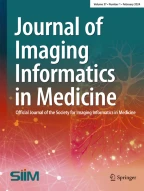Abstract
Computed tomography (CT) scans usually include some disadvantages due to the nature of the imaging procedure, and these handicaps prevent accurate abdomen segmentation. Discontinuous abdomen edges, bed section of CT, patient information, closeness between the edges of the abdomen and CT, poor contrast, and a narrow histogram can be regarded as the most important handicaps that occur in abdominal CT scans. Currently, one or more handicaps can arise and prevent technicians obtaining abdomen images through simple segmentation techniques. In other words, CT scans can include the bed section of CT, a patient’s diagnostic information, low-quality abdomen edges, low-level contrast, and narrow histogram, all in one scan. These phenomena constitute a challenge, and an efficient pipeline that is unaffected by handicaps is required. In addition, analysis such as segmentation, feature selection, and classification has meaning for a real-time diagnosis system in cases where the abdomen section is directly used with a specific size. A statistical pipeline is designed in this study that is unaffected by the handicaps mentioned above. Intensity-based approaches, morphological processes, and histogram-based procedures are utilized to design an efficient structure. Performance evaluation is realized in experiments on 58 CT images (16 training, 16 test, and 26 validation) that include the abdomen and one or more disadvantage(s). The first part of the data (16 training images) is used to detect the pipeline’s optimum parameters, while the second and third parts are utilized to evaluate and to confirm the segmentation performance. The segmentation results are presented as the means of six performance metrics. Thus, the proposed method achieves remarkable average rates for training/test/validation of 98.95/99.36/99.57% (jaccard), 99.47/99.67/99.79% (dice), 100/99.91/99.91% (sensitivity), 98.47/99.23/99.85% (specificity), 99.38/99.63/99.87% (classification accuracy), and 98.98/99.45/99.66% (precision). In summary, a statistical pipeline performing the task of abdomen segmentation is achieved that is not affected by the disadvantages, and the most detailed abdomen segmentation study is performed for the use before organ and tumor segmentation, feature extraction, and classification.
Similar content being viewed by others
References
Koss JE, Newman FD, Johnson TK, Kirch DL: Abdominal organ segmentation using texture transforms and a hopfield neural network. IEEE T Med Imaging 18:640–648, 1999
Zhou Y, Bai J: Multiple abdominal organ segmentation: an atlas-based fuzzy connectedness approach. IEEE T Inf Technol B 11:348–352, 2007
Wachinger C, Fritscher K, Sharp G, Golland P: Contour-Driven Atlas-Based Segmentation. IEEE T Med Imaging 34:2492–2505, 2015
Xu Z, Burke RP, Lee CP, Baucom RB, Poulose BK, Abramson RG, Landman BA: Efficient multi-atlas abdominal segmentation on clinically acquired CT with SIMPLE context learning. Med Image Anal 24:18–27, 2015
Dennis LSE: Automated Segmentation of Soft tissue in Abdominal CT scans. Dissertation, National University of Singapore, 2009
Rangayyan RM, Banik S, Boag GS: Landmarking and segmentation of computed tomographic images of pediatric patients with neuroblastoma. Int J Comput Ass Rad 4:245–262, 2009
Xu Z, Conrad BN, Baucom RB, Smith SA, Poulose BK, Landman BA: Abdomen and spinal cord segmentation with augmented active shape models. J Med Imag 3:036002, 2016
Gonzalez RC, Woods RE, Eddins SL: Digital image processing using MATLAB. New York: McGraw Hill Education, 2009
Lim JS: Two-Dimensional Signal and Image Processing, Englewood Cliffs: Prentice-Hall, 1990
Korn GA, Korn TM: Mathematical handbook for scientists and engineers: Definitions, theorems, and formulas for reference and review. Mineola: Courier Corporation, 2000
Zuiderveld K: Contrast limited adaptive histogram equalization. In: Heckbert PS (Ed.), Graphics gems IV. San Diego: Academic Press Professional Inc., 1994, pp 474–485
Chuang KS, Tzeng HL, Chen S, Wu J, Chen TJ: Fuzzy c-means clustering with spatial information for image segmentation. Comput Med Imag Grap 30:9–15, 2006
Yang Y, Huang S: Image Segmentation by Fuzzy C-Means Clustering Algorithm with A Novel Penalty Term. Comput Inform 26:17–31, 2007
Clark K, Vendt B, Smith K, Freymann J, Kirby J, Koppel P, Moore S, Phillips S, Maffitt D, Pringle M, Tarbox L, Prior F: The Cancer Imaging Archive (TCIA): Maintaining and Operating a Public Information Repository. J Digit Imaging 26:1045–1057, 2013
Albertina B, Watson M, Holback C, Jarosz R, Kirk S, Lee Y, Lemmerman J: Radiology data from the cancer Genome Atlas Lung Adenocarcinoma [TCGA-LUAD] collection. Cancer Imaging Arch, 2016. https://doi.org/10.7937/K9/TCIA.2016.JGNIHEP5
Labatut V, Cherifi H: Accuracy measures for the comparison of classifiers. arXiv: 1207.3790, 2012
Franklin SW, Rajan SE: Computerized screening of diabetic retinopathy employing blood vessel segmentation in retinal images. Biocybern Biomed Eng 34:117–124, 2014
Sethi G, Saini BS: Computer aided diagnosis system for abdomen diseases in computed tomography images. Biocybern Biomed Eng 36:42–55, 2016
Alivar A, Danyali H, Helfroush MS: Hierarchical classification of normal, fatty and heterogeneous liver diseases from ultrasound images using serial and parallel feature fusion. Biocybern Biomed Eng 36:697–707, 2016
Lee H, Troschel FM, Tajmir S, Fuchs G, Mario J, Fintelmann FJ, Do S: Pixel-Level Deep Segmentation: Artificial Intelligence Quantifies Muscle on Computed Tomography for Body Morphometric Analysis. J Digit Imaging, 2017, pp 1–12
Koyuncu H, Ceylan R: A hybrid tool on denoising and enhancement of abdominal CT images before organ & tumour segmentation. In: 37th IEEE International Conference on Electronics and Nanotechnology (ELNANO 2017). Kiev: IEEE, 2017, pp 249–254. https://doi.org/10.1109/ELNANO.2017.7939757
Koyuncu H, Ceylan R: Elimination of White Gaussian Noise in Arterial Phase CT Images to Bring Adrenal Tumours into the Forefront. Comput Med Imaging Graph, 2017
Koyuncu H, Ceylan R: Optic disc segmentation with Kapur-ScPSO based cascade multithresholding. In: International Conference on Bioinformatics and Biomedical Engineering. Cham: Springer, 2016, pp 206–215. https://doi.org/10.1007/978-3-319-31744-1_19
Otsu N: Thresholds selection method form grey-level histograms. IEEE T Syst Man Cyb 9:62–66, 1979
Acknowledgements
This work is supported by the Coordinatorship of Selcuk University’s Scientific Research Projects.
Author information
Authors and Affiliations
Corresponding author
Rights and permissions
About this article
Cite this article
Koyuncu, H., Ceylan, R., Sivri, M. et al. An Efficient Pipeline for Abdomen Segmentation in CT Images. J Digit Imaging 31, 262–274 (2018). https://doi.org/10.1007/s10278-017-0032-0
Published:
Issue Date:
DOI: https://doi.org/10.1007/s10278-017-0032-0
